This is my daily post. I write daily but send my newsletter to your email only on Sundays. Go HERE to see my past newsletters.
HAND-CURATED FOR YOU
Pymnts Intelligence surveyed 216,679 consumers in 11 countries and found that consumers are abandoning cash for digital wallets.
The shift is underway, and within the survey group, 35% of online and 21% of in-store purchases are now made with digital wallets, representing a 10% and 5.2% increase, respectively, over the past two years.
For perspective, in China, where digital wallets rule, 81% of online and over 56% of in-store transactions were made using them!
With Asia leading the way in digital wallets, it was unsurprising to find that among the 11 nations surveyed, the highest in-store use of digital wallets was in Singapore and Japan, occupying the first and second spots.
Digital wallets, however, aren’t just big in Asia, and the nations leading in percentage change from 2022 were the unlikely EU pair, France and the Netherlands.
For now, much of the digital wallet revolution in the West is based on pass-through wallets, such as Apple Pay and Google Pay, which access debit and credit cards. But will this last?
With stablecoins, a digital euro CBDC, and private wallet companies like Alipay or PayTM, it’s not clear that pass-through wallets will always be in the lead, especially with their high embedded card fees.
Contrary to what many believe, neither demographics nor income levels nor even where people live drives wallet adoption.
Mobile wallet adoption is primarily fueled by four user personas: Skeptics, Dabblers, Persuadable, and Committed users. Each persona requires a focused engagement strategy.
👉Digital Wallets The Payment of Choice:
🔹 Mobile Wallets are changing how consumers pay
Mobile wallets now account for 35% of online purchases across the 11 countries in this study. While some of these transactions replace cash, they are largely changing the form factor consumers use to pay for purchases. But rather than make credit and debit cards obsolete, mobile wallets securely store and tokenize them.
🔹 Mobile wallets drive mobile payment adoption as global wallets expand
Tailored, local mobile-first experiences are reshaping the competitive landscape. Global wallets like Apple Pay and Google Wallet, along with local solutions like Pix and iDEAL, are steadily gaining ground. In Japan, 44% of online transactions now occur through native wallets, and in Brazil, 14%.
🔹 Mobile wallet adoption is driven by local behaviors and availability of acceptable substitutes
Mobile wallet adoption is shaped by local behaviors and trusted substitutes, not just infrastructure. In Japan, super apps like Line Pay and widespread QR code use have made wallets a natural replacement for cash and cards, driving 35% of in-store usage. In Singapore, strong digital trust and early mobile banking adoption have accelerated wallet use.
🔹 Demographic trends in the shift to mobile wallets
Gen Z1 shows the strongest momentum, with a 23% increase in mobile wallet usage for in-store transactions since 2022. However, growth is also evident among millennials, Gen X and even baby boomers, confirming that mobile-first payments are transitioning from a youth trend to a cross-generational behavior shift.






